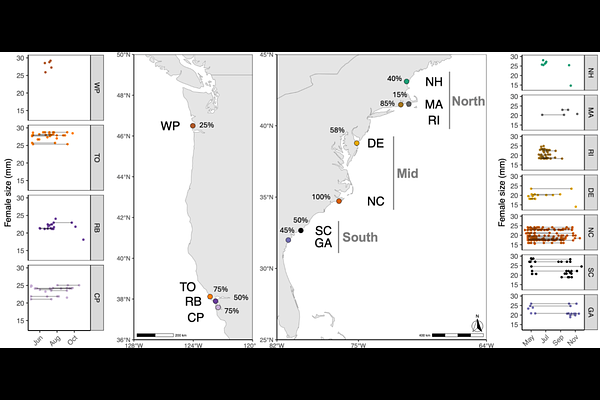Fast and slow-paced reproductive life history across native and invasive populations of a predatory marine snail

Fast and slow-paced reproductive life history across native and invasive populations of a predatory marine snail
Rugila, A.; Bucari, E.; Rawson, E.; Schlaug, A.; Komoroske, L. M.; Cheng, B. S.
AbstractPopulations across a species range may be locally adapted, and failure to recognize this variation can lead to inaccurate predictions of their resilience or vulnerability to climate change. Because life history traits are directly linked to fitness, life history theory can serve as a useful framework for evaluating how populations within species may respond to rapid environmental change. However, relatively few studies quantify multiple life history traits and their tradeoffs across many populations, especially in marine taxa. Here, we used a 10-month laboratory experiment to quantify a suite of reproductive traits in populations spanning the strongest latitudinal temperature gradient in the worlds coastal oceans. We examined reproductive traits in wild-captured adults exposed to simulated local conditions for 7 native Atlantic and 4 introduced Pacific populations of the marine predatory gastropod Urosalpinx cinerea. Our data reveals that reproductive season length, the number of reproductive attempts, and annual fecundity unimodally peaked at mid-latitude populations, the species range-center. Introduced populations had comparably few spawning attempts and low fecundity despite a longer reproductive period in a less seasonal environment. We then conducted a second experiment quantifying thermal tolerance of developing embryos from 3 native populations, which revealed high sensitivity to temperature at early life stages but weak population differentiation. Taken together, our data reveal stark differences in reproduction that appear to reflect fast and slow paced lifestyles, which may maximize fitness by spreading the risk of reproductive failure over a single season or lifetime. Our results indicate that warm range-edge populations are highly vulnerable to warming, as low embryonic thermal tolerance may shorten the spawning season and warming is likely to reduce fecundity. This study highlights heterogeneity in life history traits across marine populations that may underlie differential vulnerability to climate warming.